You’ve no doubt have noticed that we had the Edinburgh Interactive Entertainment Festival (EIEF)
As a reader of Digital-Lifestyles, you well know that Convergence isn’t just about your mobile phone and toaster becoming one (!), it’s also about content types coming closer together and, in some cases blending. At the extreme, we think it’s arguable that TV could be in a whole heap of trouble when video games become photo-realistic. Why watch TV when you can _be_ in the programme?
We went to EIEF last year and were impressed with the quality of the sessions and the delegates, who were all jolly friendly.
As you’d expect, we’ll be covering it from the ground next week, not hiding in an office waiting for the press releases to arrive like many other publications.
Set over Monday 21st and Tuesday, there’s a host of strong conference sessions arranged, covering a wide range of subjects, not just the obvious. Here’s our highlights.
In the Monday Keynote David Gardner, Executive V-P and COO of EA’s World Wide Studios is delving in to the challenges and opportunity of developing for the next gen consoles, such xbox360, Sony PS3, Nintnedo Wii.
The UK press has occasionally thrown a fit about the realism of video games, in some cases leading to the changing of blood colour in some games. This is basis of the Green Blood vs Red Blood session which will debate the implications of HDTV and photorealistic graphics for the games industry. Wise to debate it in advance, rather than wait for the censors.
Ben Sawyer of Serious Games explores “Games That Heal � the medicine of interactive software.” Examining how games are being used to help patients with conditions ranging from cancer to post-traumatic stress disorder.
To end off the night, Edge will be holding their Award and networking party at the Jam House.
Tuesday
If you’re living your Digital-Lifestyle, you’ll be aware of Machinima – where computer games are used to create films. One of the original was Red vs Blue where the footage was grabbed from Xbox mega-title Halo and voiced-over to create a drama. This has now grown to have many episodes – at least 83 we’re aware of.
In the session, find out just how far Machinima has gone into the mainstream and yet has managed to retain its rebellious and experimental approach.
The icing on the cake of this session is the world premiere of a live machinima performance from Rooster Teeth, the creators of above mentioned Red vs Blue.
The other session highlight is ‘When Alice Met Elvis’, which explores taking games beyond the screen, into other medias and how it impacts the creative process.
Author Kate Pullinger will unveil the World Premiere of the third part of her Inanimate Alice series, a ‘unique kinetic experience’, part game, part novel, part film.
When you want to bring all of those elements together, it’s not something that’s going to happen if you leave it to the last moment. To bring this into focus the founders of Velvetelvis will share their experiences in trying to encourage the “fusion” of all potential commercial elements � film, games, music, web, books – at the very beginning of a new project.
As if all of that wasn’t enough to keep you busy, there’s a series of screenings at the Odeon cinema on Lothian Road of Lord of the Rings� Online: Shadows of Angmar; Reservoir Dogs video game; Spongebob Squarepants; and Crackdown from Dave Jones, creator of the Grand Theft Auto series and Lemmings.
We told it was a strong line up, didn’t we? See you there.
 Last year took ourselves to Berlin to attend IFA. Being the first time we’d attended we were _totally_ blow away at the size of the place – it’s massive. Every side of the Consumer Electronics (CE) industry was covered, from the smallest to the largest with the later building their own houses (Siemens, Deutsche Telekom).
Last year took ourselves to Berlin to attend IFA. Being the first time we’d attended we were _totally_ blow away at the size of the place – it’s massive. Every side of the Consumer Electronics (CE) industry was covered, from the smallest to the largest with the later building their own houses (Siemens, Deutsche Telekom). Asked why IFA was so loved by trade visitors, his answer was simple, “We treat them as VIP’s. Nothing is too much and they feel very special.” Sounds like a recipe for success to us, one that could easily be learned by many other shows around the world.
Asked why IFA was so loved by trade visitors, his answer was simple, “We treat them as VIP’s. Nothing is too much and they feel very special.” Sounds like a recipe for success to us, one that could easily be learned by many other shows around the world. Despite so much current talk from the UK Telco’s and Sky on the magic that will provide an on demand broadcast TV proposition in the UK, tangible evidence of a working model beyond KiT in Hull and Homechoice is pretty sparse.
Despite so much current talk from the UK Telco’s and Sky on the magic that will provide an on demand broadcast TV proposition in the UK, tangible evidence of a working model beyond KiT in Hull and Homechoice is pretty sparse. Despite the somewhat limited selection of programmes, which I’m told is largely down to copyright issues, it seems a positive move for a public sector broadcaster actually providing a service and solving the ‘problem’ of letting you see a programme you forgot to record or you later discover is worth viewing.
Despite the somewhat limited selection of programmes, which I’m told is largely down to copyright issues, it seems a positive move for a public sector broadcaster actually providing a service and solving the ‘problem’ of letting you see a programme you forgot to record or you later discover is worth viewing. The BBC is thinking beyond the present Windows-only solution. Speaking recently in London the BBC’s Project Director for iMP Ben Lavender reinforced the BBC philosophy of platform agnosticism and spoke of the desire to work on Apple and Linux solutions when DRM issues can be satisfactorily dealt with.
The BBC is thinking beyond the present Windows-only solution. Speaking recently in London the BBC’s Project Director for iMP Ben Lavender reinforced the BBC philosophy of platform agnosticism and spoke of the desire to work on Apple and Linux solutions when DRM issues can be satisfactorily dealt with. The Economist is a publication that we regard highly. It’s not for nothing that they gained a strong reputation. Sadly a recent piece on the Digital Home let them down.
The Economist is a publication that we regard highly. It’s not for nothing that they gained a strong reputation. Sadly a recent piece on the Digital Home let them down. This was repeated with halls and halls of identikit stands. Remove the brand names and it would have been a challenge to tell them apart.
This was repeated with halls and halls of identikit stands. Remove the brand names and it would have been a challenge to tell them apart. Where The Economist got it wrong #2 – MSMedia Centre PCs are a failure
Where The Economist got it wrong #2 – MSMedia Centre PCs are a failure Although on the surface Nikon’s brand new Coolpix P1 and the Coolpix P2 cameras look like standard fare from the photo giant, they’ve got a trick up their sleeve – they both offer Wireless LAN support (IEEE802.11b/g).
Although on the surface Nikon’s brand new Coolpix P1 and the Coolpix P2 cameras look like standard fare from the photo giant, they’ve got a trick up their sleeve – they both offer Wireless LAN support (IEEE802.11b/g). This wireless connection lets users transfer images off the camera’s storage card or transmit them ‘live’ as they’re snapped directly to Nikon’s PictureProject software.
This wireless connection lets users transfer images off the camera’s storage card or transmit them ‘live’ as they’re snapped directly to Nikon’s PictureProject software. As for the Coolpix P1 and P2 cameras, there’s nothing much to get too excited about, with the two identical cameras offering 8.0 and 5.1 Megapixels respectively with a 3.5x optical zoom (36-126mm equivalent, f2.7 – 5.2).
As for the Coolpix P1 and P2 cameras, there’s nothing much to get too excited about, with the two identical cameras offering 8.0 and 5.1 Megapixels respectively with a 3.5x optical zoom (36-126mm equivalent, f2.7 – 5.2). Framing and viewing images is taken care of with a sizeable 110,000 pixels 2.5″ TFT LCD screen and there’s a SD slot and USB 2.0 connectivity onboard.
Framing and viewing images is taken care of with a sizeable 110,000 pixels 2.5″ TFT LCD screen and there’s a SD slot and USB 2.0 connectivity onboard. Promptly filed under “Gimme! Gimme! Gimme!” at first peek, Toshiba are debuting a portable LED pocket projector at the Internationale Funkaustellung (IFA) trade show 2005 in Berlin.
Promptly filed under “Gimme! Gimme! Gimme!” at first peek, Toshiba are debuting a portable LED pocket projector at the Internationale Funkaustellung (IFA) trade show 2005 in Berlin. Inside there’s a panel fitted with different coloured LEDs which serve both as the light source and the means to determine the colour of the projected images.
Inside there’s a panel fitted with different coloured LEDs which serve both as the light source and the means to determine the colour of the projected images. Siemens have announced their new Gigaset SL75 WLAN Voice-over-IP (VoIP) cordless telephone for the home.
Siemens have announced their new Gigaset SL75 WLAN Voice-over-IP (VoIP) cordless telephone for the home. Decked out in (ahem) “the season’s high fashion colour night grey”, the Gigaset SL75 WLAN sports a colour display (128×128 pixels, 4k/65k colors) and comes with a small docking station.
Decked out in (ahem) “the season’s high fashion colour night grey”, the Gigaset SL75 WLAN sports a colour display (128×128 pixels, 4k/65k colors) and comes with a small docking station. Samsung have unveiled their sleek, credit-card sized Miniket VP-MS15 digital camera at the Berlin IFA show.
Samsung have unveiled their sleek, credit-card sized Miniket VP-MS15 digital camera at the Berlin IFA show. Connecting the Miniket via USB 2.0 also lets it be used as a Webcam or a ‘portable hard drive’.
Connecting the Miniket via USB 2.0 also lets it be used as a Webcam or a ‘portable hard drive’. Samsung have also released two identical-looking smaller brothers to the MS15; the VP-MS11, with 128MB of onboard memory. and the VP-MS10 with 64MB.
Samsung have also released two identical-looking smaller brothers to the MS15; the VP-MS11, with 128MB of onboard memory. and the VP-MS10 with 64MB.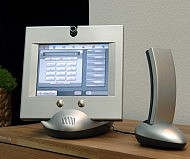 Deutsche Telekom have just announced that they will be rolling out 50 Mbit/s connection in 50 cities around Germany by 2007.
Deutsche Telekom have just announced that they will be rolling out 50 Mbit/s connection in 50 cities around Germany by 2007. The “we’ll make the country globally competitive by installing high speed Internet access, but it needs to be made worth our while” argument has been used before by other incumbent telcos when they are trying to get good, or better deals from the regulators.
The “we’ll make the country globally competitive by installing high speed Internet access, but it needs to be made worth our while” argument has been used before by other incumbent telcos when they are trying to get good, or better deals from the regulators.